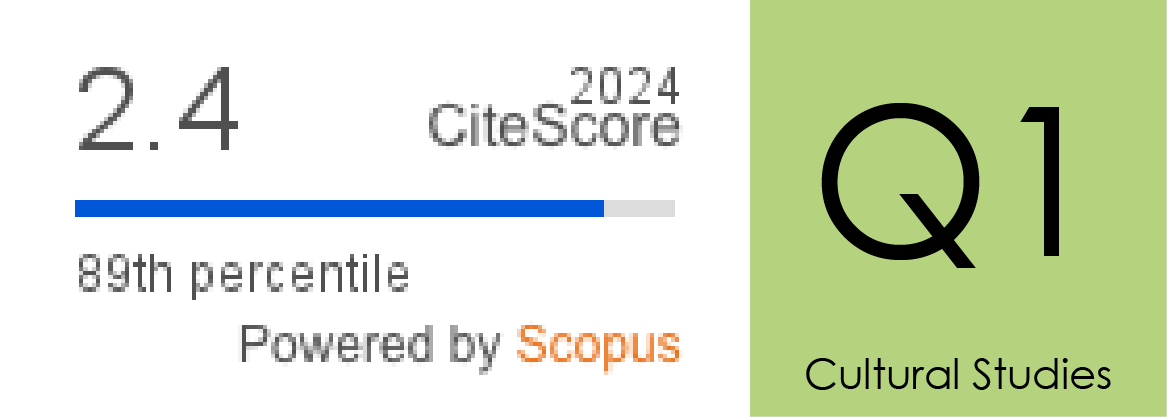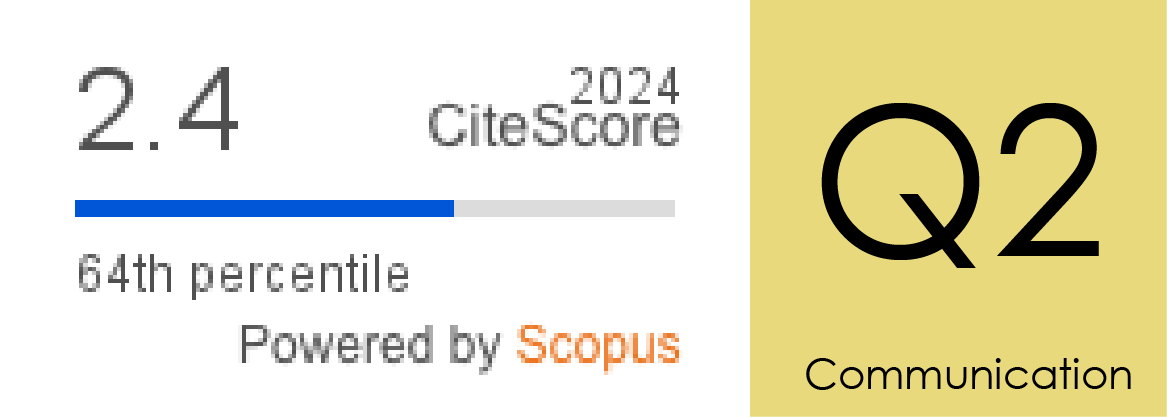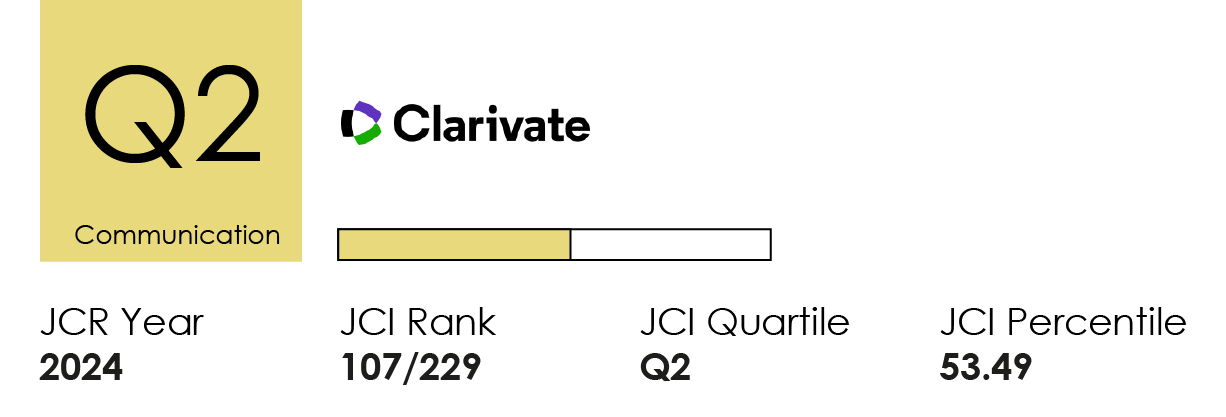La obesidad en los ciberdiarios españoles: de la estigmatización (del obeso) a la responsabilidad social y a las soluciones estructurales
DOI:
https://doi.org/10.14198/MEDCOM.24327Palabras clave:
Obesidad, ciberdiarios, agenda-setting, framing, estigmatización, Covid.Resumen
La obesidad se ha convertido en la pandemia de los países desarrollados. En España, hay más de 23 millones de personas con sobrepeso y la previsión apunta a 3,1 millones de casos nuevos hasta 2030. El objetivo de esta investigación es conocer cómo los medios tratan este tema. Para ello, se han recogido las noticias de seis ciberdiarios españoles publicadas en 2020 y 2021 a partir de tres palabras clave: obesidad, obesidad infantil y sobrepeso (n=2.760). Para un posterior análisis más exhaustivo, se han seleccionado las noticias de 2021 en las que la obesidad es el tema principal (n= 385) y se ha recurrido al análisis de contenido para analizar la temática y al framing para estudiar el enfoque. Los resultados muestran que se ha producido un cambio de estrategia: la obesidad se enfoca más con una perspectiva social que individual, se ha dejado de estigmatizar a los obesos y, en su lugar, se hace responsable del clima obesogénico a los gobiernos, al sistema educativo y la industria alimentaria. La coincidencia de este estudio con la pandemia y el año posterior han permitido obtener unos resultados genuinos. De hecho, se pude sostener que el confinamiento ha contribuido a generar en los medios esa perspectiva social de la obesidad. A pesar de que las referencias a las mujeres son escasas y, de que cuando se producen se relacionan con una visión estética, se puede concluir que los ciberdiarios están empezando a asumir su rol para proponer soluciones que afronten de raíz la problemática de la obesidad.
Financiación
Ministerio de Ciencia e Innovación. Gobierno de EspañaCitas
Almuiña-Fernández, C., Martín-de-la-Guardia, R. y Pelaz-López, J. V. (2020). Sensacionalismo y amarillismo en la Historia de la Comunicación. Fragua, Madrid
Aranceta-Bartrina, J. (2016). Periodismo y alimentación. Influencia de los medios en la elección de alimentos y en los hábitos de consumo alimentario [Tesis doctoral, Universidad del País Vasco]. ADDI.ehu.eus. https://bit.ly/3YUayU1
Armentia-Vizuete, J. I., & Marín, F. (2018). How the Spanish press frames obesity: A study of content published by El País, La Vanguardia and El Correo in 2015. Journalism, 21(12), 1932-1950. https://doi.org/10.1177/1464884918754851
Armentia-Vizuete, J. I., Marín-Murillo, F., Rodríguez-González, Marúa-del-Mar., y Marauri-Castillo, I. (2019). De qué habla la prensa digital cuando habla de nutrición. Un análisis de elpais.com y lavanguardia.com durante 2017. Doxa Comunicación, 29, 19-41. https://doi.org/10.31921/doxacom.n29a1
Argiñano, J. L. (2021). Bebidas energéticas en los cibermedios: fuentes, encuadres y falacias en la construcción de un discurso indulgente. Revista Mediterránea de Comunicación, 12(1), 221-233. https://doi.org/10.14198/MEDCOM000002
Arroyo-Johnson, C., & Mincey, K. D. (2016). Obesity epidemiology worldwide. Gastroenterol Clin, 45(4), 571–579. https://doi.org/10.1016/j.gtc.2016.07.012
Atanasova, D., Koteyko, N., & Gunter, B. (2012). Obesity in the news: Directions for future research. Obesity Reviews, 13, 554–559.
Atanasova, D., & Koteyko, N. (2017). Obesity frames and counter-frames in British and German online newspapers. Health, 21(6), 650-669. https://doi.org/10.1177/1363459316649764
Bastian, A. (2011). Representations of childhood obesity in Australian newsprint media and academic literature. Australian and New Zealand Journal of Public Health, 35(2), 135–139. https://doi.org/10.1111/j.1753-6405.2011.00660.x
Boero, N. (2007). All the news that's fat to print: The american obesity epidemic and the media. Qualitative Sociology, 30(1), 41-60. https://doi.org/10.1007/s11133-006-9010-4
Breilh J. (2008). Latin American critical ('social') epidemiology: new settings for an old dream. International journal of epidemiology, 37(4), 745–750. https://doi.org/10.1093/ije/dyn135
Brownell, K. D., Schwartz, M. B., Puhl, R. M., Henderson, K. E., & Harris, J. L. (2009). The need for bold action to prevent adolescent obesity. Journal of Adolescent Health, 45(3). https://doi.org/10.1016/j.jadohealth.2009.03.004
Busam, B., & Solomon-Moore, E. (2021). Public understanding of childhood obesity: Qualitative analysis of news articles and comments on facebook. Health Communication, 38(5), 967-980. https://doi.org/10.1080/10410236.2021.1985859
Canadian Medical Association [CMA]. (2015). CMA recognizes obesity as a disease. https://bit.ly/3WJDcFK
Castelló-Martínez, A., y Tur-Viñes, V. (2020). Una combinación de alto riesgo: obesidad, marcas de alimentación, menores y retos en YouTube. Gaceta Sanitaria, 35(4), 352-354. https://doi.org/10.1016/j.gaceta.2020.06.018
Chan, M (2016). Obesity and diabetes: The slow-motion disaster keynote address at the 47th meeting of the National academy of medicine. World Health Organization. https://onx.la/7c67c
Choban, B., Atkinson, R., & Moore, B. J. (1996). Shape up America! Guidance for treatment of adult obesity. Bethesda.
Chong, D., & Druckman, J. N. (2007). Framing theory. Annual Review of Political Science, 10(1), 103–126. https://doi.org/10.1146/annurev.polisci.10.072805.103054
Clifford, D., Ozier, A., Bundros, J., Moore, J., Kreiser, A., & Morris, M. N. (2015). Impact of non-diet approaches on attitudes, behaviors, and health outcomes: A systematic review. Journal of Nutrition Education and Behavior, 47(2), 143–155. https://doi.org/10.1016/j.jneb.2014.12.002
Couch, D, Thomas, S.L., & Lewis, S. (2015) Obese adults’ perceptions of news reporting on obesity: The panopticon and synopticon at work. SAGE Open. https://doi.org/10.1177/2158244015612522
Crawford, R. (2006). Health as a meaningful social practice. Health, 10, 401-420.
De Brún, A., McKenzie, K., McCarthy, M., & McGloin, A. (2012). The emergence and portrayal of obesity in the Irish times: Content analysis of obesity coverage, 1997–2009. Health Communication, 27(4), 389–398.
Dugmore, J. A., Winten, C. G., Niven, H. E., & Bauer, J. (2020). Effects of weight-neutral approaches compared with traditional weight-loss approaches on behavioral, physical, and psychological health outcomes: A systematic review and meta-analysis. Nutrition Reviews, 78(1), 39–55. https://doi.org/10.1093/nutrit/nuz020
Eilders C., & Lüter A. (2000). Research note: Germany at war: Competing framing strategies in German public discourse. European Journal of Communication, 15(3), 415-428.
Entman, R. M. (1993). Framing: Toward a clarification of a fractured paradigm. Journal of Communication, 43, 51–58.
Flores-Peña, Y., Trejo-Ortiz, P. M., Gallegos-Cabriales, E. C., & Cerda-Flores, R. M. (2009). Validez de dos pruebas para evaluar la percepción materna del peso del hijo. Salud Pública de México, 51(6), 489-495.
Fúster, F., Ribes, M. Ángel, Bardón, R., & Marino, E. (2009). Análisis cuantitativo de las noticias de alimentación en la prensa madrileña en 2006. Revista Española de Documentación Científica, 32(1), 99–115. https://doi.org/10.3989/redc.2009.1.664
García-Arnaiz, M. (2011). La obesidad como enfermedad, la obesidad como problema social. Revista de la Facultad de Medicina de la UNAM, 54(3), 20-28.
Gard, M., & Wright, J. (2005) The Obesity Epidemic: Science, Morality and Ideology. Taylor & Francis.
Gilbert, M., Raman, J., & Sui, Z. (2019). Cognitive remediation enabled cognitive behaviour therapy for obesity: a case series. Eat Weight Disord, 26, 103-114. https://doi.org/10.1007/s40519-019-00823-4
Goffman, E. (2006). Frame analysis. Los marcos de la experiencia. Centro de Investigaciones Sociológicas.
Health Care Organization (2020). Ann Intern Med. 173 (10), 773-781. https://bit.ly/3GefDOm
Hernáez, A., Zomeño, M. D., Dégano, I. R., Pérez-Fernández, S., Goday, A., Vila, J., Civeira, F, Moure, R., y Marrugat, J. (2019). Exceso de peso en España: situación actual, proyecciones para 2030 y sobrecoste directo estimado para el Sistema Nacional de Salud. Revista española de cardiología, 72(11), 916-924. https://doi.org/10.1016/j.recesp.2018.07.009
Hilton, S., Patterson, C., & Teyhan A. (2012). Escalating Coverage of Obesity in UK Newspapers: The Evolution and Framing of the “Obesity Epidemic” From 1996 to 2010. Obesity, 20(8), 1688-1695. https://doi.org/10.1038/oby.2012.27
Iyengar, S. (1989). How citizens think about national issues: A matter of responsibility. American Journal of Political Science, 33(4), 878–900. https://doi.org/10.2307/2111113
Iyengar, S. (1991). Is anyone responsible? How television frames political issues. University of Chicago Press.
Jenkin, G. L., Signal, L. & Thomson, G. (2011), Framing obesity: the framing contest between industry and public health at the New Zealand inquiry into obesity. Obesity Reviews, 12, 1022-1030. https://doi.org/10.1111/j.1467-789X.2011.00918.x
Jeong, M., Gilmore, J. S., Bleakley, A., & Jordan, A. (2014). Local news media framing obesity in the context of a sugar-sweetened beverage reduction media campaign. Journal of Nutrition Education and Behavior, 46(6), 583–588. https://doi.org/10.1016/j.jneb.2014.04.294
Kim, S. H., & Willis, L. A. (2007). Talking about obesity: news framing of who is responsible for causing and fixing the problem. Journal of Health Communication, 12(4), 359–376. https://doi.org/10.1080/10810730701326051
Krippendorff, K. (2004). Content analysis: an introduction to its methodology. Sage.
Kwan, S. (2009), Framing the Fat Body: contested meanings between Government, activists, and Industry. Sociological Inquiry, 79, 25-50. https://doi.org/10.1111/j.1475-682X.2008.00271.x
L’Hôte, E., Fond, M., & Volmert, A. (2018). Seeing upstream mapping the gaps between expert and public understandings of health in the United Kingdom. FrameWorks Institute. https://bit.ly/3jPlPVP
Losada, A., Germanos, G., y Adrio, L. (2020). Estilo parental percibido en adolescentes con trastorno de la conducta alimentaria. Perspectivas Metodológicas, 20. https://doi.org/10.18294/pm.2020.2687
Marauri-Castillo, I., Rodríguez-González, M. M., Armentia-Vizuete, I., y Marín-Murillo, F. (2021).
Estrategia exitosa de información sobre alimentación dirigida a ‘millennials’: el caso de Carlos Ríos en Instagram. Revista Mediterránea de Comunicación, 12(1), 253-267. https://doi.org/10.14198/MEDCOM000001
Marín-Murilo, F., Armentia-Vizuete, J. I., Marauri-Castillo, I., & Rodríguez-González, M. M. (2020). Tratamiento del azúcar en la prensa digital española: análisis comparativo. En T. Baiget (Ed.), Comunicación y diversidad. Selección de comunicaciones del VII Congreso Internacional de la Asociación Española de Investigación de la Comunicación (pp. 291-304). Ediciones Profesionales de la Información, S.L. https://doi.org/10.3145/AE-IC-epi.2020
Maher, J., Fraser, S., & Wright, J. (2010). Framing the mother: Childhood obesity, maternal responsibility and care. Journal of Gender Studies, 19(3), 233–247.
Mathieu-Bolh, N. (2021). The elusive link between income and obesity. Journal Economy Surves, 1(34). https://doi.org/10.1111/joes.12458
McCombs, M. y Evatt, D. (1995). Los temas y los aspectos. Explorando una nueva dimensión de la agenda setting. Comunicación y Sociedad, 1(8), 7-32.
Mejía-Galván, I. T. y Padrós-Blázquez, F. (2018). Incidencia de la percepción de los padres sobre los estilos educativos parentales en el sobrepeso y obesidad infantil. Revista electrónica de psicología Iztacala, 21(1). https://revistas.unam.mx/index.php/repi/article/view/64017
Ministerio de Consumo. (2019). Estudio sobre la alimentación, actividad física, desarrollo infantil y obesidad en España. Estudio ALADINO 2019. https://bit.ly/3UN1qNX
Miralles, M., Chilet-Rosell, E., y Hernández-Aguado, I. (2021) Encuadre mediático de la obesidad infantil en las noticias de prensa generalista en España. Gaceta Sanitaria, 35(3), 256-259. https://doi.org/10.1016/j.gaceta.2019.09.010
Nimegeer, A., Patterson, C., & Hilton, S. (2019). Media framing of child-hood obesity: A content analysis of UK newspapers from 1996 to 2014. BMJ Open, 9(4). https://doi.org/10.1136/bmjopen-2018-025646
Olveira-Araujo, R, & Argiñano, J. L. (2021). The portrayal of sex in online media as conflictive, feminized behavior far from hedonic pleasure. Profesional de la información, 30(5). https://doi.org/10.3145/epi.2021.sep.07
Organización Mundial de la Salud [OMS]. (17/10/2016). Obesity and diabetes: the slow-motion disaster Keynote address at the 47th meeting of the National Academy of Medicine. https://bit.ly/3Y9l2yA
Ortiz-Barreda, G., Viver-Cases, C., y Ortiz-Moncada, R. (2012) La cobertura periodística de la obesidad en la prensa española (2000–2005). Perspectivas en nutrición humana, 14(1), 23–32.
Parrot, R. (2004). Emphasizing ‘Communication’ in Health Communication. Journal of Communication, 54(4), 751-787.
Pavía, J.M.; López, G.; Palau, D.; Rubio. A.; Valera, L. y Gámir, J. (2017). Encuesta GIPEyOP / Mediaflows sobre Medios y Comunicadores. https://www.uv.es/pavia/Informe_Encuesta_Medios.pdf
Penkler, M., Felder, K., & Felt, U. (2015). Diagnostic narratives: creating visions of Austrian society in print media accounts of obesity. Science Communication, 37(3), 314-339. https://doi.org/10.1177/1075547015575791
Reese, S. D. (2001). Framing public life: A brigding model for media research. In S. D. Reese, O. Gandy, & A. Grant (eds.), Framing public life: Perspectives on media and our understanding of the social world (pp. 7-31). Lawrence Erlbaum.
Royo-Bordonada, M. A., Rodríguez-Artalejo, F., Bes-Rastrollo, M., Fernández-Escobar, C., González, C. A., Rivas, F., Martínez-González, M. _A., Quiles, J., Bueno-Cavanillas, A., Navarrete-Muñoz, E. M., Navarro, C., López-García, E., Romaguera, D., Suárez-Varela, M., y Vioque, J. (2019). Políticas alimentarias para prevenir la obesidad y las principales enfermedades no transmisibles en España: querer es poder. Gaceta Sanitaria, 33(6), 584-592. https://dx.doi.org/10.1016/j.gaceta.2019.05.009
Ryan, W. (1976). Blaming the victim. Vintage.
Saguy, A. C., & Almeling, R. (2008) Fat in the fire? Science, the news media, and the “obesity epidemic”. Sociological forum, 23(1), 53–83. https://doi.org/10.1111/j.1600-0838.2004.00399 .x-i1
Salmon, C. T. (1989). Campaign for social improvement: An overview of values, rationales,and impacts. In C. T. Salmon (Ed.), Information campaign: Balancing social values and social change (pp. 19–53). Sage.
Semetko, H. A., & Valkenburg, P. M. (2000): Framing European Politics: A Content Analysis of Press and Television News. Journal of Communication, 50(2), 93-109.
Serdula, M. K., Mokdad, A. H., Williamson, D. F., Galuska, D. A., Mendlein, J. M., & Heath, G. W. (1999). Prevalence of attempting weight loss and strategies for controlling weight. JAMA, 282, 1353–1358.
Shekar, M. y Popking, B. (2020). Obesity: health and economic consequences of an impending global challenge (Human development perspectives). World Bank Publications.
Su, Y., Xiao, X., & Shu, W. (2020). The effect of message cues on stigmatization and support: An examination of obesity-related conversations on Weibo. Online Journal of Communication and Media Technologies, 10(2). https://doi.org/10. 29333/ojcmt/7831
Sun, Y., Krakow, M., John, K. K., Liu, M., & Weaver, J. (2016). Framing obesity: How news frames shape attributions and behavioral responses. Journal of Health Communication, 21(2), 139-147. https://doi.org/10.1080/10810730.2015.1039676
Sun, S., He, J., Shen, B., Fan, X., Chen, Y., & Yang, X. (2021). Obesity as a “self-regulated epidemic”: Coverage of obesity in chinese newspapers. Eating and Weight Disorders, 26(2), 569-584. https://doi.org/10.1007/s40519-020-00886-8
Tartof, S. Y., Qian, L., Hong, V., Wei, R., Nadjafi, R. F., Fischer, H., Li, Z., Shaw, S. F., Caparosa, S. L., Nau, C. L., Saxena, T., Rieg, G. K., Ackerson, B. K., Sharp, A. L., Skarbinski, J., Naik, T. K., & Murali, S. B. (2020). Obesity and mortality among patients diagnosed with COVID-19: results from an Integrated Health Care Organization. Annals of internal medicine, 173(10), 773–781. https://doi.org/10.7326/M20-3742
Ulijaszek, S. J., y McLennan, A. K. (2016). Framing obesity in UK policy from the Blair years, 1997–2015: The persistence of individualistic approaches despite overwhelming evidence of societal and economic factors, and the need for collective responsibility. Obesity Reviews, 17(5), 397–411. https://doi.org/10.1111/obr.12386
Van Dijk, T., & Kintsch, W. (1983). Strategies of discourse comprehension. New York Academic Press.
Van Hooft, J., Patterson, C., Loft, M., Alexandrou, C., Hilton, S., & Nimegeer, A. (2017). Media framing and construction of childhood obesity: a content analysis of Swedish newspapers. Obesity Science& Practice, 4(1), 4-13.
Wikler D. (2002). Personal and social responsibility for health. Ethics & international affairs, 16(2), 47–55. https://doi.org/10.1111/j.1747-7093.2002.tb00396.x
World Health Organization [WHO]. (09/06/2013). Obesity and overweight. https://bit.ly/3YXyo13
Descargas
Estadísticas
Publicado
Cómo citar
Número
Sección
Licencia
Derechos de autor 2018 Jose Luis Arguiñano Herrarte, Guillermo Gurrutxaga Rekondo

Esta obra está bajo una licencia internacional Creative Commons Atribución 4.0.
Los autores y autoras que publican en esta revista están de acuerdo con los siguientes términos:
1 Derechos de autor. Los autores y autoras conservan sus derechos de autor, aunque ceden a la revista de forma no exclusiva los derechos de explotación (reproducción, distribución, comunicación pública y transformación) y garantizan a esta el derecho de primera publicación de su trabajo, el cual estará simultáneamente sujeto a la licencia indicada en punto 2. Los autores pueden establecer otros acuerdos adicionales para la distribución no exclusiva de la versión de la obra publicada en la revista, siempre que exista un reconocimiento de su publicación inicial en esta revista.
© Los autores.
2 Licencia. Los trabajos se publican en la revista sujetos a la licencia de Reconocimiento 4.0 Internacional de Creative Commons (CC BY 4.0); los términos se pueden consultar en https://creativecommons.org/licenses/by/4.0/
Esta licencia permite a terceros compartir (copiar y redistribuir el material en cualquier medio o formato) y adaptar (remezclar, transformar y crear a partir del material para cualquier finalidad, incluso comercial), siempre que se reconozca la autoría y la primera publicación en esta revista (Revista Mediterránea de Comunicación (RMC) / Mediterranean Journal of Communication (MJC), Universidad de Alicante, DOI de la obra), se proporcione un enlace a la licencia y se indique si se han realizado cambios en la obra.
3 Política de autoarchivo. Se recomienda a los autores que difundan sus trabajos a través de Internet para favorecer una circulación y difusión más rápidas y, con ello, un posible aumento en la citación y alcance entre la comunidad científica y académica, en las siguientes condiciones:
No se permite a los autores depositar en un repositorio institucional o temático, página web propia, etc., las versiones preprint (versión antes de ser evaluada) o postprint (versión evaluada y aceptada para su publicación) de sus trabajos antes de su publicación, pero sí el artículo final publicado (versión del editor).













